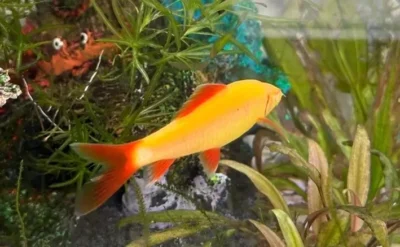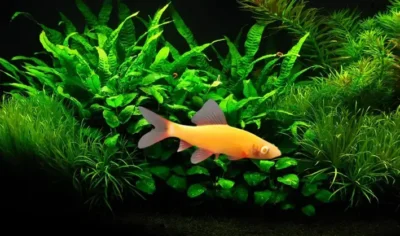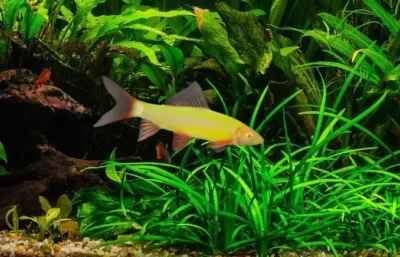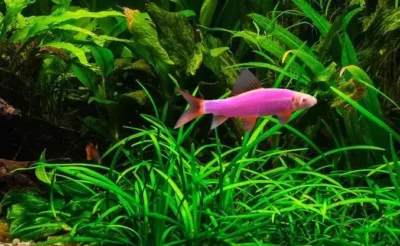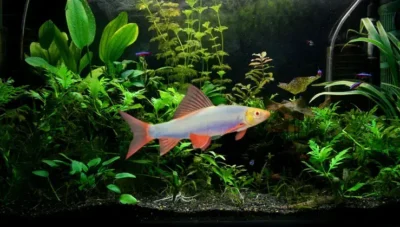Glofish sharks or glow sharks are genetically modified versions of species like the Rainbow Shark (Epalzeorhynchos frenatum). Initially, Scientists introduced genes from marine organisms like jellyfish and sea anemones into these freshwater fish to produce fluorescent colors to become glofish Sharks. These modifications are now inheritable and the fluorescent traits are passed on to their offspring. The glofish sharks are popular due to their vibrant colors that glow in lighting conditions. They are easy to take care of and require less maintenance.
GloFish sharks are tropical fish but some GloFish sharks become semi-aggressive and more often claim specific areas of the tank as their own and may chase away other fish that encroach on their territory. So it is recommended to keep only one glofish shark in a single tank. Some fishkeepers report success in keeping multiple GloFish sharks together when they are kept in a large tank (75 gallons or more) with a lot of hiding space in the form of natural caves and plants to prevent territorial disputes.
Glofish sharks have a sleek and streamlined body shape similar to their natural counterparts such as the Rainbow Shark. Glofish sharks come in various fluorescent colors, such as Cosmic Blue, Electric Green, Galactic Purple, and Sunburst Orange. These colors appear strikingly bright under blue LED lights. They are active swimmers and are often seen swimming at the bottom and mid-levels of the tank.
Glofish Shark Colors
Below are the currently available GloFish Shark colors.
- Sunburst Orange.
- Electric Green.
- Galactic Purple.
- Cosmic Blue.
Sunburst Orange Glofish Shark:
Appearance
- Color: They appear bright, fluorescent orange, and almost luminescent, especially under blue LED lights or black lights.
- Under white light, the Sunburst Orange GloFish Shark maintains its bright, fluorescent orange color, though the effect is less pronounced compared to blue LED or black light. They won’t glow as dramatically as it does under specialized lighting.
- Body: The body is sleek similar to the Rainbow Shark and appears in a sunburst orange color.
- Fins: The fins appear dark orange, adding to the overall brightness.
Electric Green Glofish Shark:
Appearance
- Color: They appear in electric green or neon green that glows brightly under blue LED lighting.
- Under white light, the electric green GloFish Shark maintains its bright electric green color, though the effect is less pronounced compared to blue LED or black light.
- Body: Similar sleek, shaped body like a rainbow shark and appears electric green
- Fins: Often appear dark bright orange, enhancing the fish’s overall fluorescence.
Galactic Purple Glofish Shark:
Appearance
- Color: They appear in galactic purple or Striking purple that glows brightly under blue LED lighting.
- Under white light, the galactic purple color is less pronounced compared to blue LED or black light.
- Body: Same sleek-shaped body and appears bright purple.
- Fins: Usually appear orange and purple, complementing the body color.
Cosmic Blue Glofish Shark:
Appearance
- Color: They appear light vibrant blue that shines brightly under blue or black LED lighting. The brightness is less pronounced under white light.
- Body: Same sleek shape and appears cosmic blue.
- Fins: Blue and orange, adding to the overall beauty.
Glofish Shark Size:
GloFish shark size is similar in size to their non-fluorescent counterparts like the Rainbow Shark.
The Juvenile GloFish sharks are typically around 1 to 2 inches in length. A GloFish shark full size is about 5 to 6 inches in length which is reached at adulthood. In some cases, they can grow up to the size of 8 inches in length if the tank is sufficiently large and if it is well-fed.
A Full-Grown Glofish Shark Jumbo
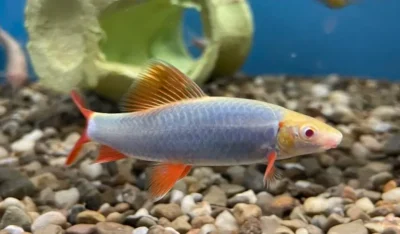
The Glofish Sharks grow relatively slowly reaching their full size over about a year to a year and a half, depending on the care and conditions provided. Regular monitoring and proper care are important during their growth phase to ensure they develop to their full potential size.
Factors Influencing Glofish Shark Size
Tank Size: Adequate space is crucial for the healthy growth of GloFish sharks. A minimum tank size of 30 gallons is required for a glofish shark, but they grow much faster and bigger in larger tanks (70 gallons or more).
Diet: A varied and balanced diet supports healthy, faster growth, and maximum growth. High-quality flake or pellet food, along with occasional live or frozen foods and vegetable matter helps them grow faster and bigger in size.
Glofish Shark Tank Size:
If you are planning to keep a GloFish shark, you must ensure the appropriate Glofish Shark tank size which is crucial for their health and well-being to manage their semi-aggressive nature. GloFish Sharks require adequate space and a well-planned aquarium setup to thrive. Due to their mild territorial nature and active behavior, they require a suitable environment that meets their specific needs. Here are some recommendations for tank size and setup:
Minimum Tank Size:
For a single Glofish Shark, At least a 20-gallon tank is recommended with a good amount of bottom space. However, a larger tank is always better to provide them with sufficient space for swimming and making their territory.
For multiple GloFish Sharks, you need a larger tank with 40 gallons or more with good bottom space due to its semi-aggressive nature and territorial behavior. More space helps reduce territorial aggression and provides a more stable environment for a glofish shark. As a rule of thumb, you can add 20 gallons more for each glofish shark you introduce with a lot of natural caves and plants to establish their territories.
Ideal Tank Size:
For a single GloFish Shark, the ideal tank size is of 30 gallons or larger with a large bottom space. It offers ample swimming space, reduces stress, and keeps the fish healthy.
For keeping multiple GloFish Sharks in the range of two or more, a tank of 70 gallons plus with more bottom space is ideal. This can ensure that each fish can establish its territory and reduce the chances of aggressive behavior between the fishes. It is also important to set up hiding spaces in the tank in the form of caves and plants to establish their territories.
Glofish Shark Tank Mates:
Choosing appropriate Glofish Shark Tanks mates is crucial due to their semi-aggressive nature. Here are some suitable and unsuitable companions based on
- Choose Peaceful, Active, and Fast Swimming Fishes: Due to the semi-aggressive and mild territorial natures of Glofish Sharks, the ideal tank mates are those who can easily escape and evade the Glofish Shark if needed. Peaceful, fast-swimming species such as tetras, barbs, and danios can be good choices to get along with Glofish sharks. Tetras, barbs, and danios tend to stay in the upper and middle sections of the tank and hence can stay away from Glofish Sharks which are mostly bottom dwellers. Also, avoid similar species like Rainbow sharks to avoid territorial disputes.
- Limit Bottom dwellers: Since Glofish Sharks are bottom dwellers it is better to limit the number of other bottom-dwelling species to prevent competition for space. However, you can keep some algae eaters such as certain plecos and snails, which can coexist with Glofish Sharks.
- Consider the Size of Tank Mates: Select fish that are not large and aggressive which might bully the Glofish Shark. Medium-sized, peaceful fish make the best companions.
Considering the above aspects into consideration here are the best Glofish Tank Mate recommendations:
Suitable Glofish Shark Tank Mates:
- Large Tetras and Barbs
- Example: Black Skirt Tetra, Serpae Tetra, Tiger Barb, Rosy Barb and Cherry Barb.
- Characteristics: Fast swimmer and a peaceful temperament. similar water requirements.
- Gourami’s
- Examples: Blue Gourami, Pearl Gourami
- Characteristics: Medium size and stay at the top and middle levels of the tank reducing chances of conflict.
- Danios
- Example: Zebra Danio, Giant Danio
- Characteristics: Fast, agile swimmers that tend to stay in the upper and middle levels of the tank, reducing conflict.
- Corydoras Catfish
- Examples: Bronze Corydoras, Panda Corydoras, and Bristlenose Plecos.
- Characteristics: Peaceful bottom dwellers that stay out of the GloFish shark’s way.
Unsuitable Tank Mates:
- Small, Slow-Moving Fish
- Examples: Guppies, Neon Tetras
- Reason: They can be harassed or bullied by large GloFish sharks.
- Long-Finned Fish
- Examples: Angelfish, Betta Fish
- Reason: Their long fins can target Glow sharks by nipping, causing stress and injury.
Glofish Shark Water Parameters:
GloFish sharks, like their Rainbow Shark counterparts, are moderately tolerant of a range of water conditions. However, maintaining the proper water parameters is essential for the health, well-being, and longevity of GloFish sharks. Here are the recommended water conditions for keeping GloFish sharks:
Glofish Shark Water Temperature:
Maintaining a stable temperature within the below-specified range is crucial, as fluctuations can cause stress and make your Glofish Sharks more susceptible to disease.
- Range: 72-82°F
- Optimal: Around 75-78°F
Water pH:
A neutral pH is ideal, but GloFish sharks can tolerate slightly acidic to slightly alkaline conditions as long as you keep the pH stable.
- Range: 6.5-7.5
- Optimal: Around 7.0
Water Hardness:
Moderate water hardness is suitable for GloFish sharks. Consistency in water hardness is more important to keep them stress-free.
- Range: 5-15 dGH (degrees of General Hardness)
- Optimal: 8-12 dGH(degrees of General Hardness)
Ammonia, Nitrite, and Nitrate Levels in Water:
The ideal Ammonia and nitrite for any fish is close to zero, as they can be toxic to fish. Nitrate should be kept below 20 ppm through regular water changes, through use of good filters, and proper tank maintenance.
- Ammonia: Ideally close to Zero ppm ( parts per million)
- Nitrite: Ideally close to Zero ppm ( parts per million)
- Nitrate: < 20 ppm
Water Filtration:
A good filtration system helps maintain water quality by removing waste, toxins, and excess food, ensuring a healthy environment for GloFish sharks. External filters with multiple filter mediums are the best for all types of fish. Internal filters with efficient mechanical, biological, and chemical filtration will also do a good job of maintaining the water quality. Also, it is essential to maintain good aeration to maintain good oxygen levels in water.
Monitoring:
- Regular Testing: Use a reliable water testing kit to regularly check ammonia, nitrite, nitrate, pH, and hardness levels.
- Observation: Keep an eye on the fish for signs of stress or illness. Changes in behavior, color, appetite, or any disease may indicate water quality issues.
By maintaining these water parameters, you can create a stable and healthy environment for your GloFish sharks, ensuring that they live healthy.
Glofish shark lifespan
GloFish sharks have a life span of about 5 to 8 years similar to their counterparts the Rainbow Shark. Several factors influence the Glofish shark lifespan:
Factors Influencing the Lifespan:
- Water Quality: Maintaining clean and well-oxygenated water is crucial for the longevity of Glofish Sharks. Regular water changes, proper filtration, and monitoring for stable water parameters like temperature, pH, and hardness are essential to prevent stress and disease.
- Diet: A balanced and varied diet contributes to overall health and longevity. Provide high-quality feed that contains both animal matter and vegetable matter.
- Tank Size: An adequately sized tank reduces stress and aggression to establish their territories. A minimum of 20 gallons is recommended for a single GloFish shark. If you intend to house more than one glow fish shark then larger tanks with more than 40 gallons to 70 gallons are preferable.
- Tank Mates: Choosing compatible tank mates to avoid conflicts between other fishes. Infighting can lead to injuries and stress. Low levels of stress contribute toward the longevity of a Glofish Shark.
- Disease Prevention: Regular monitoring for signs of illness and prompt treatment can prevent the spread of disease and increase lifespan.
Glofish shark Food:
GloFish sharks are omnivores and require a balanced diet consisting of both plant and animal matter to stay healthy and vibrant. Since Glo sharks are bottom dwellers they require food that can sink into the bottom of the tank. Make sure you choose high-quality food to prevent water clouding.
Here are some suitable GloFish Shark food:
Commercial Fish Food:
Flakes: High-quality flake food Optimized for GloFish sharks can be a good choice. The flakes you provide should be soft so that they can be bitten and consumed or swallowed as a whole. Make sure the flakes contain plant matter like spirulina and animal matter silkworms, brine shrimp, etc.
Pellets: Sinking pellets are ideal since GloFish sharks often feed at the bottom of the tank. Make sure the pellets you choose, contain high amounts of spirulina and animal matter like silkworm and krill. You can provide food that is consumed by bottom dwellers like catfish and Loaches to your Glofish Shark.
Live Food:
Live Bloodworms: You can feed your Glofish shark with live blood worms occasionally which would be a nutritious treat for them.
Brine Shrimp: You can occasionally feed you Glofish with brine shrimp which is an excellent source of protein.
Daphnia: Dahnia is another nutritious treat for your Glofish Shark which is rich in protein.
Blanched Vegetables: Blanched cucumber, spinach, and peas can be added to their diet occasionally to improve digestion.
Glofish Shark Price:
The GloFish Shark price can vary depending on several factors like the fish’s size, coloration, quality, and demographic location. Here’s a general price range you might expect to find for GloFish Sharks:
Juvenile GloFish Shark: Prices for young or juvenile Rainbow Sharks can start from around $5 to $15, depending on their size and coloration.
Adult GloFish Shark: For larger and more mature Rainbow Sharks with well-developed coloration and size, prices can range from $15 to $30 or more per fish.

